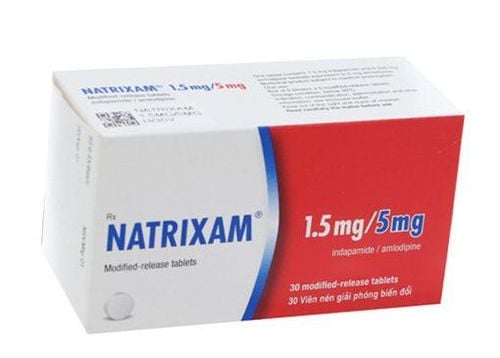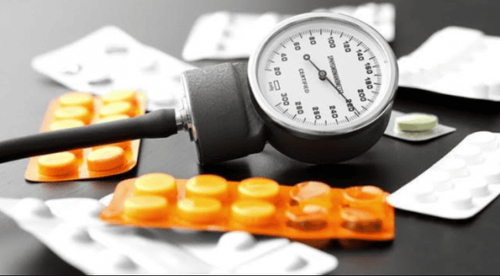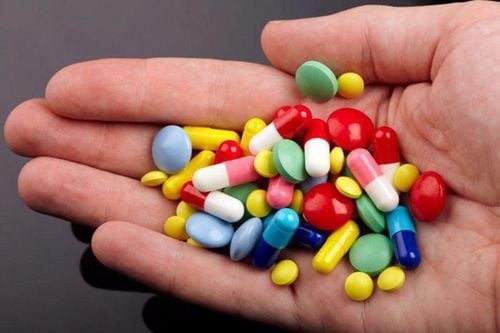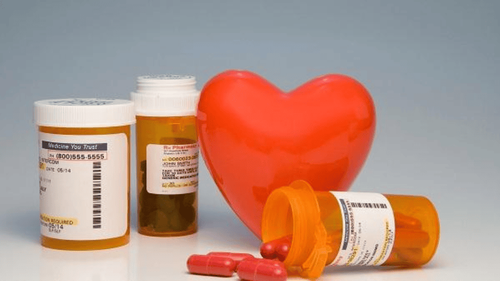This is an automatically translated article.
Becamlodin drug contains the main ingredient Amlodipine, a drug for treating high blood pressure of the calcium channel blocker group. The mechanism of action of the drug is to block calcium channels in vascular smooth muscle, causing peripheral arterial smooth muscle relaxation and lowering blood pressure.
1. What is Becamlodin?
What is Becamlodin? Becamlodin is a widely used antihypertensive drug in clinical practice. Becamlodin medicine contains the main ingredient Amlodipine with the strength of 5mg. Amlodipine is a calcium channel blocker to treat high blood pressure. The mechanism of action of the drug is a voltage-dependent L-type calcium channel blocker, acting on vascular and cardiac smooth muscle, thereby relaxing peripheral arterial smooth muscle and lowering blood pressure. The drug does not reduce atrioventricular conduction in the heart and does not adversely affect myocardial contractility. Amlodipine is also effective in reducing renal vascular resistance, increasing renal blood flow and improving renal function in patients.
2. Uses of the drug Becamlodin
Becamlodin is indicated in the following cases:
Treatment of essential hypertension Treatment of stable angina, angina caused by vasoconstriction
3. Dosage and usage of Becamlodin
When treating hypertension and angina, the dose of Becamlodin will depend on the characteristics of the individual patient. In general, the usual starting dose is 2.5 - 5 mg once daily. The dose can be increased gradually, spaced 7-14 days to 10mg/time/day. For elderly patients, patients with impaired liver function: It is recommended to use a lower starting dose, about 2.5 mg / time / day. Children ≥ 6 years: The usual effective dose of Becamlodin is 2.5 - 5 mg/time/day. Safety and efficacy have not been established at doses exceeding 5 mg/day.
4. Contraindications of the drug Becamlodin
Becamlodin is contraindicated in patients with known hypersensitivity to amlodipine, dihydropyridine derivatives or any of the excipients.
5. What are the side effects of Becamlodin?
The most common side effect of Becamlodin was dose-related ankle edema. In addition, patients using Becamlodin may experience the following side effects:
Common, ADR > 1/100
Whole body: Ankle edema, headache, dizziness, flushing, fatigue. Cardiovascular: Palpitations. Central nervous system: Asthenia, cramps. Gastrointestinal: Nausea, vomiting, abdominal pain, dyspepsia. Respiratory: Difficulty breathing. Uncommon, 1/1000 < ADR < 1/100
Cardiovascular: Excessive hypotension, tachycardia, chest pain, ischemia, syncope Skin: Rash, pruritus. Musculoskeletal: Muscle pain, joint pain. Gastrointestinal: Anorexia, constipation Psychiatric: Sleep disturbance. Rarely, ADR <1/1000
Circulatory: Extrasystoles. Skin: Urticaria. Liver: Increased liver enzymes, including transaminases, alkaline phosphatase, lactate dehydrogenase. Metabolic: Hyperglycemia. Mental: Confusion. Immunity: Erythema multiforme.
6. Notes when using the drug Becamlodin
During the use of Becamlodin, patients should note:
Hypotension: Symptomatic hypotension may occur. Acute hypotension at the beginning of treatment is unlikely as the effects begin slowly. Aortic stenosis: Amlodipine should be used with caution in patients with severe aortic stenosis, as it may reduce coronary perfusion leading to ischemia. Heart Failure: With the exception of Amlodipine, calcium channel blockers should be avoided whenever possible in patients with heart failure with reduced ejection fraction. Amlodipine can be used to treat hypertension or ischemic heart disease in patients with heart failure with reduced ejection fraction. Hepatic impairment: Use with caution in patients with hepatic impairment. A lower starting dose and gradual increase in dose may be required in patients with severe hepatic impairment. Amlodipine should be used with caution in patients with hypertrophic cardiomyopathy and left ventricular outflow tract obstruction, as the reduction in afterload may exacerbate symptoms associated with this pathology. Pregnancy: The general risk of taking antihypertensive drugs is alteration of blood flow by peripheral vasodilation, decreased placental perfusion, and hypoxia to the fetus. In animal experiments, calcium channel blockers have been shown to cause teratogenicity and skeletal malformations. Therefore, Amlodipine should be avoided in pregnant patients, especially during the first 3 months of pregnancy. Lactation: There are no data on the accumulation of Amlodipine in breast milk, so it should not be used in lactating women.
7. Becamlodin drug interactions
In order to ensure optimal effectiveness of the drug and prevent side effects during the use of Becamlodin, patients should note some of the following interactions:
Anesthetic drugs can increase the antihypertensive effect. of Amlodipine and may cause a more drastic drop in blood pressure. Lithium: When used together with Becamlodin can cause neurotoxicity such as nausea, vomiting, diarrhea. Nonsteroidal anti-inflammatory drugs may reduce the antihypertensive effect of Amlodipine by inhibiting prostaglandin synthesis and/or sodium and water retention. Drugs with high plasma protein binding (warfarin, valproic, ...) must be used with caution with Amlodipine because Amlodipine can compete with protein binding, so the concentration of free forms of the above drugs changes. Ideally, the patient should inform the medical staff of all drugs and dietary supplements being used for specific advice.
The above information is for reference only and cannot replace the guidance of medical personnel. If you have any questions about Becamlodin, you should contact your doctor or pharmacist for advice.
Follow Vinmec International General Hospital website to get more health, nutrition and beauty information to protect the health of yourself and your loved ones in your family.
Please dial HOTLINE for more information or register for an appointment HERE. Download MyVinmec app to make appointments faster and to manage your bookings easily.













